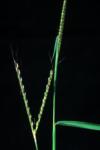Latin name
Ischaemum rugosum Salisb.
Family
Poaceae
Common name(s)
Wrinkle duck beak, saromacca grass
Synonym(s)
Andropogon arnottianus (Nees) Steudel, Colladoa distachia Cav., Ischaemum akoense Honda, I. segetum Trin., Meoschium arnottianum Nees, M. griffithii Nees & Arn., M. rugosum (Salisb.) Nees
Geographical distribution
Asia: China.
South and Southeast Asia: Bangladesh, Cambodia, India, Indonesia, Lao PDR, Malaysia, Myanmar, Nepal, Pakistan, Philippines, Sri Lanka, Thailand, and Vietnam.
Rest of the world: Australia, Colombia, Ecuador, Fiji, Madagascar, Nicaragua, Peru, Venezuela, and West Africa.
Morphology
An erect or ascending annual or perennial; up to 100—cm—tall.
Stem: often purplish, usually has hairs at nodes, cylindrical.
Leaf: blades 10—30—cm—long, glabrous or with scattered hairs on both surfaces; compressed sheaths rather loose and green or purplish, with hairs on margins; ligule membranous and fused with auricles.
Inflorescence: paired terminal spikes that are often strongly pressed against one another, thus appearing like a single spike. At maturity, it separates into two spike-like racemes. Spikelets paired, one is sessile, the other pedicelled; sessile spikelet yellowish green, up to 6—mm—long, first glume prominently transversely wrinkled; awns spiral at base, dark colored.
Biology and ecology
Propagates by seeds. Seeds do not germinate while submerged though, after emergence, they can grow easily under flooded conditions.
Ischaemum rugosum is found in wet conditions, especially in direct-seeded rice fields.
Agricultural importance
Ischaemum rugosum is a serious weed in lowland direct-seeded rice, where it emerges later than many weeds in the crop and is favored by shallow flooding.
Also an alternate host of Chaetocnema basalis (Baly), Cicadulina bipunctata (Melichar), Hysteroneura setariae (Thomas), Leptocorisa acuta (Thunberg), Nisia carolinensis Fennah, Orseolia oryzae (Wood-Mason), Pseudococcus saccharicola Takahashi, Sesamia inferens (Walker), and Tetraneura nigriabdominalis (Sasaki), and diseases caused by tungro virus. It is also a host of the nematode Meloidogyne sp.
Ischaemum rugosum is used as feed for animals. It also provides suitable material for mulch and compost.
Management
Cultural control: hand weeding or hoeing.
Chemical control: Butachlor, thiobencarb, pendimethalin, or mixtures of thiobencarb or butachlor and propanil, cyhalofop, and fenoxaprop can give effective control. Molinate is not effective in controlling I. rugosum.
Selected references
Akibo-Betts DT, Raymundo SA. 1978. Aphids as rice pests in Sierra Leone. Int. Rice Res. Newsl. 3:15-16.Catindig JLA, Barrion AT, Litsinger JA. 1995. Suitability of ricefield plants to planthopper Nisia carolinensis Fennah. Int. Rice Res. Notes 20:27.Gapasin RM, Barsalote EB, Lim JL. 1996. Survey and identification of plant parasitic nematodes associated with upland weeds and weed response to the rice root-knot nematode, Meloidogyne graminicola. Philipp. J. Weed Sci. 21:22-31.Holm LG, Plucknett DL, Pancho JV, Herberger JP. 1977. The world's worst weeds: distribution and biology. Honolulu, Hawaii (USA): University of Hawaii Press. 609 p.Noda K, Teerawatsakul M, Prakongvongs C, Chaiwiratnukul L. 1985. Major weeds in Thailand. National Weed Science Research Institute Project. Bangkok (Thailand): Department of Agriculture. 142 p.Moody K. 1989. Weeds reported in rice in South and Southeast Asia. Manila (Philippines): International Rice Reseach Institute. 442 p.Pancho JV, Obien SR. 1995. Manual of ricefield weeds in the Philippines. Muñoz, Nueva Ecija (Philippines): Philippine Rice Research Institute. 543 p.Rivera CT, Ling KC, Ou SH. 1969. Suspect range of rice tungro virus. Philipp. Phytopathol. 5:16-17.
Contributors
JLA Catindig, RT Lubigan, and DE Johnson
